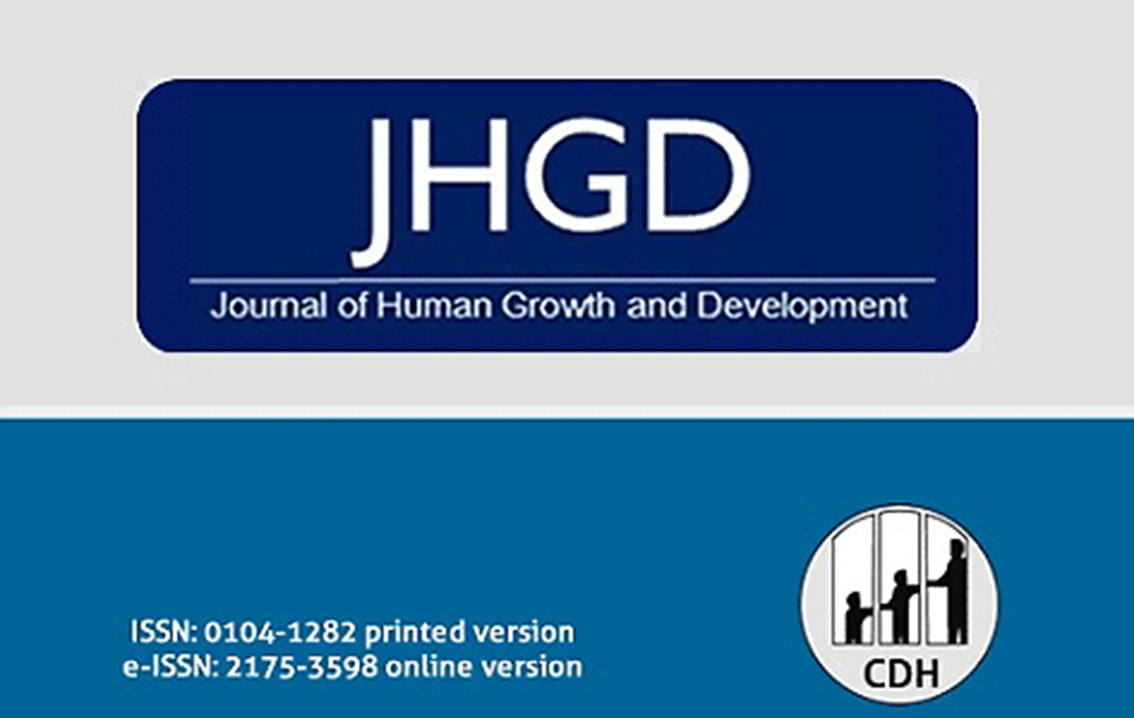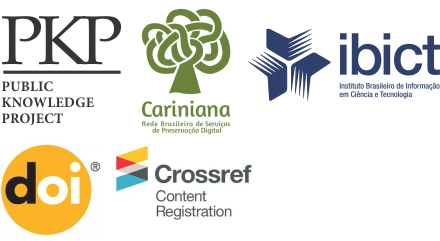Effects of 12 weeks of interdisciplinary interventions on behavioral and eating parameters of adolescents with overweight or obesity
DOI:
https://doi.org/10.7322/jhgd.v29.9417Keywords:
food behavior, interdisciplinary research, adolescent healthAbstract
Objetctive: To analyze the 12 weeks’ effects of interdisciplinary interventions on behavioral and eating parameters of overweight or obese adolescents. Methods: This study presents a longitudinal and quasiexperimental design. 40 adolescents aged 16 ± 1 years were selected to participate on the study. Therefore, only 17 completed the 12 weeks of interdisciplinary interventions. The interventions were realized by physical education professionals (physical exercises three times a week), physiotherapists (exercises to strengthen the core and postural exercises three times a week), nutrition (feeding re-education twice a week) and cognitive-behavioral therapy (focus on behavior change and adoption of an active lifestyle once a week). In order to quantify the adolescents’ behavioral parameters, the questionnaires were: Body Shape Questionnaire (BSQ), Eating Attitudes Test (EAT), Rosenberg self-esteem scale (RAS) and Hamilton anxiety scale (HAS). Results: For BSQ’s answer 9: “are you with thin people of the same sex as you, make you feel worried about your physique? “A significant reduction in the responses attributed by the adolescents at the post-intervention (p<0.05) level was identified, as well as for the HAS, in question 3: fear - of the dark, of unknown, of the crowd, of being abandoned, large animals, transit”, with lower values (p<0.05) after interdisciplinary interventions. Conclusion: Interdisciplinary interventions resulted in improvements in body image in relation to the perception of physical state, as well as in a decrease in fear presented by adolescents. The 12 weeks of interventions presented slight changes in the adolescents’ behavior analyzed in the study.
Downloads
References
2. Barlow SE; Expert Committee. Expert committee recommendations regarding the prevention, assessment, and treatment of child and adolescent overweight and obesity: summary report. Pediatrics. 2007;120(Suppl 4):164-92. DOI: http://doi.org/10.1542/peds.2007-2329C
3. World Health Organization (WHO). Growth reference data for 5-19 years. Geneva: 2007.
4. Cole TJ, Bellizzi MC, Flegal KM, Dietz WH. Establishing a standard definition for child overweight and obesity worldwide: international survey. BMJ. 2000;320:1240. DOI: https://doi.org/10.1136/bmj.320.7244.1240
5. Barroso TA, Marins LB, Alves R, Gonçalves ACS, Barroso SG, Rocha GS. Associação Entre a Obesidade Central e a Incidência de Doenças e Fatores de Risco Cardiovascular. Int J Cardiovasc Sci. 2017;30(5):416-24. DOI: http://dx.doi.org/10.5935/2359-4802.20170073
6. World Health Organization (WHO). Taking action on childhood obesity report. Department of Prevention of Noncommunicable Diseases. 2018.
7. Brasil. Hábitos dos brasileiros impactam no crescimento da obesidade e aumenta prevalência de diabetes e hipertensão. Vigitel. 2016.
8. Bloch KV, Cardoso MA, Sichieri R. Study of Cardiovascular Risk Factors in Adolescents (ERICA): results and potentiality. Rev Saúde Pública. 2016;50(Suppl 1):2s. DOI: http://dx.doi.org/10.1590/s01518-8787.201605000supl1ap
9. Cuppari L. Guias de medicina ambulatorial e hospitalar: Nutrição Clínica no Adulto. 3 ed. São Paulo: Escola Paulista de Medicina da UNIFESP. 2014.
10. Serrano SQ, Vasconcelos MGL, Silva GAP, Cerqueira MMO, Pontes CM. Percepção do adolescente obeso sobre as repercussões da obesidade em sua saúde. Rev Esc Enferm USP. 2010;44(1):25-31. DOI: http://dx.doi.org/10.1590/S0080-62342010000100004
11. Alvarenga M, Figueiredo M. Timerman F, Antonaccio C. Nutrição comportamental. Manole, 2016.
12. Cheng LA, Mendonça G, Farias Júnior JC. Atividade física em adolescentes: análise da influência social de pais e amigos. J Pediatr. 2014;90(1):35-41. DOI: http://dx.doi.org/10.1016/j.jped.2013.05.006
13. Moreno R. A beleza impossível: mulher, mídia e consumo. Editora Ágora. 2008.
14. Silva RC, Cunha MN. Corpo e contemporaneidade: uma abordagem crítica sobre os padrões de beleza e consumo estético da mulher veiculados pelas mídias. Dissertação (Mestrado) - Universidade Metodista de São Paulo. São Paulo: 2017.
15. Almeida SG. A influência da imagem corporal como causa de transtornos alimentares em adolescentes escolares de uma escola da rede particular de Brasília. Ensaios Ciênc Biol Agrárias Saúde. 2014;16(6):105-17. DOI: http://dx.doi.org/10.17921/1415-6938.2012v16n6p%25p
16. Cooper PJ, Taylor MJ, Cooper Z, Fairbum CG. The development and validation of the Body Shape Questionnaire. Int J Eating Disord. 1987;6(4):485-94. DOI: https://doi.org/10.1002/1098-108X(198707)6:4<485::AID-EAT2260060405>3.0.CO;2-O
17. Nunes MA, Bagatini LF, Abuchaim AL, Kunz A, Ramos D, Silva JA, et al. Distúrbios da conduta alimentar: considerações sobre o Teste de Atitudes Alimentares (EAT). Rev ABP-APAL. 1994;16(1):7-10.
18. Avanci JQ, Assis SG, Santos ND, Oliveira RV. Adaptação transcultural de escala de auto-estima para adolescentes. Psicol Reflex Crít. 2007;20(3):397-405. DOI: http://dx.doi.org/10.1590/S0102-79722007000300007
19. Hamilton M. The assessment of anxiety states by rating. Br J Med Psychol. 1959;32(1):50-5. DOI: https://doi.org/10.1111/j.2044-8341.1959.tb00467.x
20. Campana ANNB, Campana MB, Tavares MCGCF. Escalas para avaliação da imagem corporal nos transtornos alimentares no Brasil. Avaliação Psicol. 2009;8(3):437-46.
21. Garner DM, Garfinkel PE. The Eating Attitudes Test: an index of the symptoms of anorexia nervosa. Psychol Med. 1979;9(2):273-9. DOI: https://doi.org/10.1017/S0033291700030762
22. Garner DM, Olmsted MP, Bohr Y, Garfinkel PE. The eating attitudes test: psychometric features and clinical correlates. Psychol Med. 1982;12(4):871-8. DOI: https://doi.org/10.1017/S0033291700049163
23. Bighetti F, Ribeiro RPP. Tradução e validação do Eating Attitudes Test (EAT-26) em adolescentes do sexo feminino na cidade de Ribeirão Preto-SP. Dissertação (Mestrado) - Universidade de São Paulo. Ribeirão Preto: 2003.
24. Freire MA, Figueiredo VLM, Gomide A, Jansen K, Silva RA, Magalhães PVS, et al. Escala Hamilton: estudo das características psicométricas em uma amostra do sul do Brasil. J Bras Psiquiatr. 2014;63(4):281-9. DOI: http://dx.doi.org/10.1590/0047-2085000000036
25. Wardle J, Cooke L. The impact of obesity on psychological well-being. Best Pract Res Clin Endocrinol Metab. 2005;19(3):421-40. DOI: http://dx.doi.org/10.1016/j.beem.2005.04.006
26. Rentz-Fernandes AR, Silveira-Viana M, Liz CM, Andrade A. Autoestima, imagem corporal e depressão de adolescentes em diferentes estados nutricionais. Rev Salud Pública. 2017;19(1):66-72. DOI: https://doi.org/10.15446/rsap.v19n1.47697
27. Lemos A, Bonifácio C, Caldeirita C, Francisco R, Fernandes A, Ferro-Lebres V. Relação entre os conhecimentos nutricionais e imagem corporal, em adolescentes. Adolesciência Rev Investigação. 2017;4(1):61-74.
28. Zwiauer KF. Prevention and treatment of overweight and obesity in children and adolescents. Eur J Pediatr. 2000;159(Supp1):56-68. DOI: https://doi.org/10.1007/PL00014367
29. Zambon MP, Antonio MARGM, Mendes RT, Barros Filho AZ. Crianças e adolescentes obesos: dois anos de acompanhamento interdisciplinar. Rev Paul Pediatr. 2008;26(2):130-5. DOI: http://dx.doi.org/10.1590/S0103-05822008000200006
30. Oliveira TRPR, Cunha CF, Ferreira RA. Educação nutricional como estratégia de intervenção para o tratamento da obesidade na adolescência. Rev Med Minas Gerais. 2008;18(4 Suppl.3):67-75.
31. Obelar RM, Albornoz ACG. Avaliação psicológica nos transtornos de ansiedade: estudos brasileiros. Monografia (Curso de Especialização em Avaliação Psicológica) - Universidade Federal do Rio Grande do Sul. Porto Alegre: 2016.
32. Andrade J, Bischoff LC, Bonetto L, Dias CP, Roncada C. Intervenções escolares para redução da obesidade infantil: uma revisão sistemática. Ciênc Saúde. 2015;8(2):72-8. DOI: http://dx.doi.org/10.15448/1983-652X.2015.2.19790
33. Fidelix YL, Farias JC, Lofrano-Prado MC, Guerra RLF, Cardel M, Prado WL. Multidisciplinary intervention in obese adolescents: predictors of dropout. Einstein (São Paulo). 2015;13(3):388-94. DOI: http://dx.doi.org/10.1590/S1679-45082015AO3339
34. Oliveira LC, Ferrari GLM, Araújo TL, Matsudo V. Excesso de peso, obesidade, passos e atividade física de moderada a vigorosa em crianças. Rev Saúde Pública. 2017;51:38. DOI: https://doi.org/10.1590/S1518-8787.2017051006771
35. Pereira MA, Pereira AA, Leão JM, Lisboa LCV, Elias MAR, Ghetti FF, Aguiar AS, Luquetti SCPD. Desafios e reflexões na implantação de um programa de educação alimentar e nutricional (EAN) em indivíduos com excesso de peso. Rev Bras Promoção Saúde. 2015;28(2):290-6. DOI: http://dx.doi.org/10.5020/18061230.2015.p290
36. Silveira AM, Jansen AK, Norton RC, Silva GS, Whyte PPM. Efeito do atendimento multidisciplinar na modificação dos hábitos alimentares e antropometria de crianças e adolescentes com excesso de peso. Rev Med Minas Gerais. 2010;20(3):277-84.
37. Menegat G, Silva SS, Ewald D, Lang CS. Adesão ao tratamento interdisciplinar de nutrição e psicologia em um programa de reeducação alimentar. Anais III - Congresso de Pesquisa e Extensão da FSG Salão de Extensão & Mostra Científica. 2015;3(3):879-81.
38. Masquio DCL, Damaso AR. Efeito da terapia interdisciplinar sobre a síndrome metabólica e perfil inflamatório em adolescentes com obesidade. Tese (Dourado) - Universidade Federal de São Paulo. São Paulo: 2015.
39. Fonseca H, Palmeira AL, Martins SC, Falcato L, Quaresma A. Managing paediatric obesity: a multidisciplinary intervention including peers in the therapeutic process. BMC Pediatr. 2014;14:89. DOI: http://dx.doi.org/10.1186/1471-2431-14-89
40. Piercy KL, Troiano RP, Ballard RM, Carlson SA, Fulton JE, Galuska DA, et al. The physical activity guidelines for Americans. JAMA. 2018;320(19):2020-8. DOI: http://dx.doi.org/10.1001/jama.2018.14854
41. US Preventive Services Task Force. Behavioral weight loss interventions to prevent obesity-related morbidity and mortality in adults. JAMA. 2018;320(11):1163-71. DOI: http://dx.doi.org/10.1001/jama.2018.13022
42. Magnani Branco BH, Carvalho IZ, Oliveira HG, Fanhani AP, Santos MCM, Oliveira LP, et al. Effects of 2 Types of Resistance Training Models on Obese Adolescents’ Body Composition, Cardiometabolic Risk, and Physical Fitness. J Strength Cond Res. 2018. DOI: http://dx.doi.org/10.1519/JSC.0000000000002877
43. Scheffer MLC, Pilatti LA, Kovaleski JL. Qualidade de vida e atividade física na literatura. Universidade Tecnológica Federal do Paraná. Ponta Grossa: 2015;36(3).
44. Lobo R, Batista M, Cubo SD. Prática de atividade física como fator potenciador de variáveis psicológicas e rendimento escolar de alunos do ensino primário. Rev Iberoamericana Psicol Ejercicio Deporte. 2015;10(1):85-93.
45. Silva FAL, Bezerra JAX. Benefícios da atividade física no controle da obesidade infantil. Rev Campo Saber. 2017;3(1):201-18.
46. Decol J, Hoefel AL, Zanotti J. Relato de experiência: projeto nutrir com saúde. V Congresso de Pesquisa e Extensão da FSG III Salão de Extensão. 2017;5(5):963-5.







